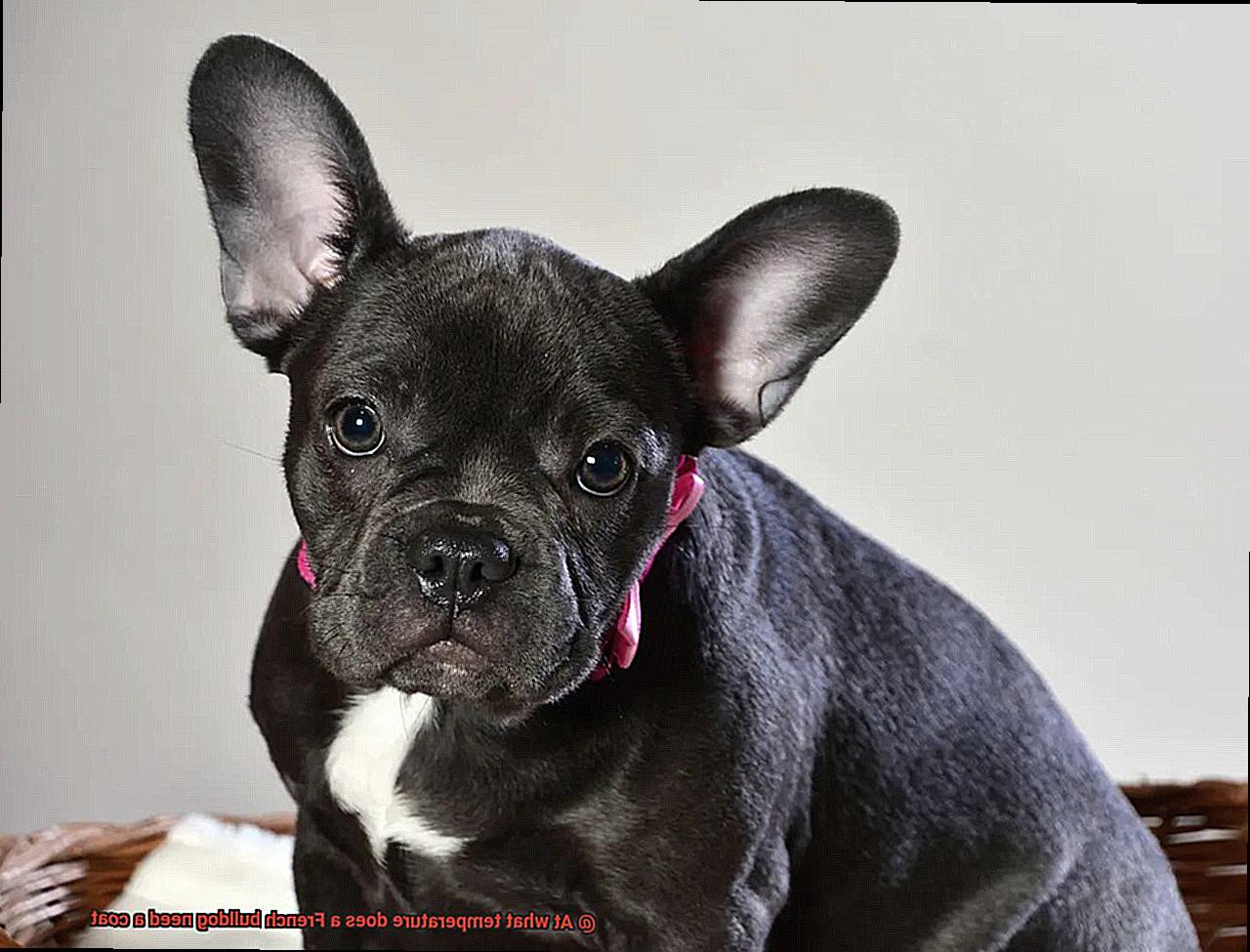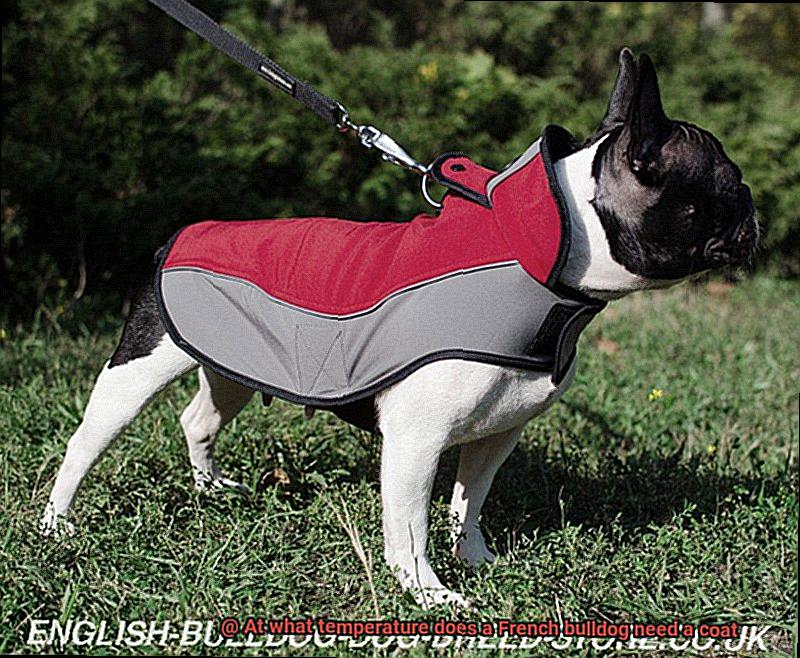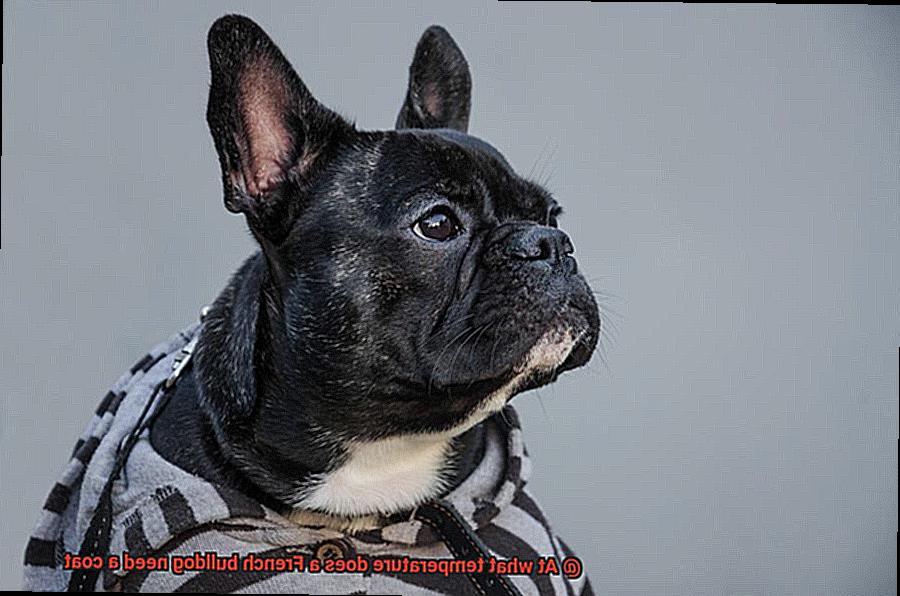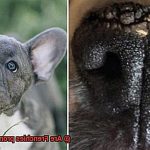At what temperature does a French bulldog need a coat?
As autumn’s chill creeps in and winter looms, it’s time to give our adorable French bulldogs the warmth they need. These lovable companions steal our hearts, but can they handle the freezing cold? When should we bundle them up in a cozy coat?
In this post, we’ll dive into the world of Frenchies, exploring their quirks, their love for snuggles, and when they need that extra layer of protection. Whether you’re a seasoned Frenchie owner or thinking about bringing one into your home, understanding their temperature needs will keep them comfy during the chilly months.
So grab a hot cocoa, get comfy, and let’s unravel the mystery of when our furry friends need some extra warmth.
French Bulldog’s Ideal Temperature Range
Contents
- 1 French Bulldog’s Ideal Temperature Range
- 2 Factors Affecting French Bulldog Comfort in Cold Temperatures
- 3 Signs of Discomfort in Cold Temperatures
- 4 Choosing the Right Coat for Your French Bulldog
- 5 Acclimating Your French Bulldog to Wearing a Coat
- 6 Overheating and Physical Activity with a Coat On
- 7 Regularly Check Your Dog’s Coat for Discomfort or Irritation
- 8 Conclusion
As a brachycephalic breed with a short muzzle and compact airways, French Bulldogs are more sensitive to extreme temperatures. In this comprehensive guide, we’ll explore their ideal temperature range, how to keep them warm in the cold, and prevent overheating in hot weather.

Understanding the Ideal Temperature Range:
French Bulldogs thrive in temperatures between 60-80 degrees Fahrenheit (15-27 degrees Celsius). Within this range, they can effectively regulate their body temperature. However, it’s important to remember that each dog is different, so factors like age, health condition, and individual tolerance can influence their preferences.
Keeping Them Warm in the Cold:
When the temperature drops below 60 degrees Fahrenheit (15 degrees Celsius), it’s time to bundle up your French Bulldog. Consider getting them a lightweight coat or sweater made of warm materials like fleece or wool. Look for a well-fitting garment that doesn’t restrict movement. Keep an eye out for signs of discomfort such as shivering or seeking warmth.
Preventing Overheating in Hot Weather:
French Bulldogs are prone to heatstroke, so it’s crucial to protect them from high temperatures. Avoid exposing them to temperatures above 80 degrees Fahrenheit (27 degrees Celsius) for extended periods. Provide shade and fresh water at all times. In hot weather, skip the coats and focus on other cooling methods like air conditioning, cooling mats or vests.
Observing Behavior and Consulting with Your Vet:
Your French Bulldog’s behavior is a great indicator of their comfort level. If they appear cold or show signs of overheating, take action accordingly. Always consult with your veterinarian for personalized advice based on your dog’s specific needs and health condition.
Factors Affecting French Bulldog Comfort in Cold Temperatures
French Bulldogs are undeniably adorable, but their short coats and brachycephalic features can make them more sensitive to cold temperatures. To ensure your furry friend stays warm and cozy during colder seasons, it’s important to understand the factors that can affect their comfort in the cold. Let’s dive into these factors and learn how to keep your French Bulldog comfortable when the mercury drops.
- Coat Length and Thickness: A French Bulldog’s coat plays a significant role in their tolerance to the cold. With their short, single-layered coat, these little cuties don’t have much natural insulation against chilly weather. Dogs with longer and thicker coats generally fare better in the cold, so it’s essential to provide extra protection for your Frenchie.
- Body Fat and Muscle Mass: The amount of body fat and muscle mass a French Bulldog has can also impact their ability to withstand cold temperatures. Dogs with a higher percentage of body fat have better insulation as fat acts as a natural insulator. Additionally, dogs with good muscle mass generate more body heat, helping them stay warm in colder weather conditions.
- Age and Health Conditions: Puppies, senior dogs, and those with underlying health conditions may be more sensitive to the cold. Puppies’ bodies are still developing, making it harder for them to regulate body temperature. Older dogs may have weakened immune systems or joint issues that can be aggravated by the cold. Dogs with respiratory problems like brachycephalic airway syndrome may also struggle more in colder weather due to compromised respiratory function.
- Acclimatization: Just like humans, dogs need time to acclimate to changing weather conditions. Gradually exposing your French Bulldog to cooler temperatures allows them to build up tolerance and adapt more effectively. Consider providing them with proper attire, such as a coat or sweater, during this acclimatization period.
- Activity Level: A French Bulldog’s activity level can impact their comfort in the cold. Dogs that are more active generate more body heat, helping them stay warm. On the other hand, dogs with limited exercise may struggle to generate enough body heat to keep warm in colder weather.
- Environmental Factors: It’s not just your Frenchie’s individual characteristics that affect their comfort in the cold, but also environmental factors. Wind chill, humidity, and precipitation can intensify the feeling of coldness. When assessing whether your French Bulldog needs extra protection, consider these factors as well.
Signs of Discomfort in Cold Temperatures
French Bulldogs are adorable, compact little pups with a lot of love to give. However, their brachycephalic nature can make them more susceptible to discomfort in extreme temperatures, especially the cold. As a responsible owner, it’s important to be aware of the signs that your French Bulldog may be feeling uncomfortable in the cold and take steps to keep them warm and cozy.
- Shivering: One of the most obvious signs that your French Bulldog is feeling chilly is shivering. Just like humans, dogs shiver as a way to generate heat and maintain their core temperature. If you notice your furry friend shaking or trembling uncontrollably, it’s a clear indication that they are feeling too cold and need some extra warmth. Consider providing them with a cozy sweater or blanket to help retain their body heat.
- Change in behavior: Another sign to look out for is a change in behavior. If your usually playful and active French Bulldog suddenly becomes lethargic or less energetic when exposed to cold temperatures, it could be a sign that they are feeling uncomfortable. They may try to seek out warm spots in your home or burrow under blankets to stay cozy.
- Body language: Pay attention to your French Bulldog’s body language. They may exhibit signs of discomfort such as hunching their back, tucking their tail between their legs, or curling up into a tight ball. These postures help them conserve body heat and protect themselves from the cold.
- Paw troubles: Cold weather can also have an impact on your French Bulldog’s paws. If you notice them lifting their paws off the ground or consistently licking their paws after being outside, it may be a sign that their paws are too cold. This can lead to frostbite or other paw injuries, so it’s important to take precautions such as using dog booties or applying paw balm to protect their sensitive paws.
- Respiratory issues: Additionally, cold air can irritate a French Bulldog’s airways, especially due to their brachycephalic nature. If you notice any signs of respiratory issues such as coughing, wheezing, or difficulty breathing, it’s crucial to seek veterinary attention as soon as possible.
Keep in mind that the temperature at which your French Bulldog may start feeling uncomfortable can vary depending on factors like age, health condition, and individual tolerance. Some French Bulldogs may be more cold-tolerant than others. However, as a general guideline, if the temperature drops below freezing (32°F or 0°C), it is recommended to provide your French Bulldog with extra warmth, such as a coat or sweater, when going outside.
Choosing the Right Coat for Your French Bulldog
When it comes to keeping your French Bulldog comfortable in colder temperatures, a well-fitting coat can make all the difference. But with so many options available, how do you choose the right one? Here are some factors to consider when selecting a coat for your furry friend.
Temperature and Weather Conditions
French Bulldogs have a short and fine coat that doesn’t provide much insulation against the cold. It’s important to consider the temperature and weather conditions before deciding if your French Bulldog needs a coat. The ideal temperature range for a French Bulldog to wear a coat is between 32°F and 50°F (0°C and 10°C). Below 32°F (0°C), it’s highly recommended to put a coat on your Frenchie to keep them warm and protect them from the cold. On the other hand, in temperatures above 50°F (10°C), your French Bulldog may become too warm in a coat and risk overheating.
Material, Size, and Style
When choosing a coat for your French Bulldog, consider the material, size, and style. The material should be warm yet lightweight and breathable to ensure your Frenchie’s comfort. Look for coats made of fleece or waterproof materials to keep them dry in wet weather. The size of the coat is also crucial – it should fit snugly but not too tight, allowing freedom of movement. There are various styles of coats available for French Bulldogs, including ones with harness holes, hoodies, and puffer jackets. Choose one that suits your dog’s needs and preferences.
Try Before You Buy
It’s advisable to try the coat on your French Bulldog before purchasing it to ensure the proper fit and comfort. Every dog is different, so what works for one may not work for another. Take note of how easy it is to put on and take off the coat, as well as any potential restrictions it may cause.
Regular Maintenance
Once you’ve found the perfect coat for your French Bulldog, it’s important to regularly check its condition. Inspect the coat for any signs of wear and tear, such as loose stitching or damaged zippers. Replace any worn-out or damaged coats promptly to ensure your Frenchie continues to stay warm and comfortable.
Acclimating Your French Bulldog to Wearing a Coat
It’s that time of year when the temperatures drop, and you start bundling up in cozy coats. But what about your French Bulldog? Just like you, they need protection from the cold too. However, some dogs may be resistant to wearing a coat initially. That’s why it’s crucial to acclimate your Frenchie gradually and make the process as positive and comfortable as possible. Here are some expert tips to help you with this process.
- Take it Slow: Rome wasn’t built in a day, and neither is your dog’s comfort with wearing a coat. Start by introducing the coat for short periods of time, allowing your Frenchie to sniff and inspect it. This will help them become familiar with the new item and reduce any anxiety or resistance.
- Proper Fit: Just like Goldilocks and her porridge, finding the right fit is essential. Ensure that the coat is not too tight or restrictive, as a well-fitting coat should allow your Frenchie to move freely and comfortably. Check for any signs of discomfort, such as restricted movement or rubbing against their skin.
- Positive Reinforcement: Who doesn’t love treats and praise? Use positive reinforcement techniques to reward your Frenchie when they wear the coat without fussing or trying to remove it. This will create a positive association with wearing the coat and make the experience more enjoyable for them.
- Start with Mild Weather: Begin using the coat during mild weather conditions when it’s not too hot or cold outside. This will help your Frenchie associate wearing the coat with comfort rather than discomfort. Gradually increase the use of the coat as the temperature drops, paying attention to their behavior and body language.
- Monitor Activity Levels: Keep an eye on your Frenchie while they’re wearing a coat, especially during physical activities or playtime. Ensure that they don’t overheat or become overheated while wearing the coat. French Bulldogs are prone to overheating, so it’s crucial to strike a balance between warmth and comfort.
Remember, each dog is unique, and what works for one Frenchie may not work for another. If your dog shows signs of distress or discomfort while wearing a coat, such as excessive panting or restlessness, it may be too warm for them. Remove the coat and provide them with a cooler environment.
Consult with your veterinarian if you have any concerns about your Frenchie’s comfort and well-being or if you’re unsure about whether they need a coat at certain temperatures. Your vet can provide personalized advice based on your dog’s individual needs.
Overheating and Physical Activity with a Coat On
If you’re a proud owner of a French Bulldog, you probably know that they are prone to overheating due to their unique anatomy. But did you know that engaging in physical activities with your Frenchie while they’re wearing a coat can further increase the risk of overheating? In this blog post, we’ll explore why it’s important to be cautious when it comes to physical activity with a coat on and provide you with practical tips to keep your furry friend safe and comfortable.
Understanding the Risks:
French Bulldogs have a short snout and flattened face, making them brachycephalic. This anatomical feature makes them more susceptible to overheating and respiratory issues. When a French Bulldog engages in physical activity, especially in hot weather or high temperatures, their body temperature can quickly rise. Wearing a coat further exacerbates the problem, as it restricts their ability to dissipate heat through panting.
Recognizing the Signs of Overheating:
To ensure the well-being of your Frenchie, it’s essential to closely monitor their behavior and body temperature during physical activity with a coat on. Signs of overheating include excessive panting, drooling, rapid breathing, lethargy, and difficulty walking. If you notice any of these signs, it’s crucial to take immediate action to prevent further overheating.

Tips for Safe Physical Activity:
- Remove the Coat: If your Frenchie shows signs of overheating while wearing a coat, remove it immediately. This will allow them to cool down more efficiently.
- Find a Cool and Shaded Area: Provide your dog with a cool and shaded area to rest. This will help them regulate their body temperature and avoid further overheating.
- Offer Fresh Water: Make sure your Frenchie has access to fresh water during and after physical activity. Hydration is crucial for preventing overheating.
- Use a Damp Cloth: If your Frenchie is overheated, gently wipe their body with a damp cloth to help cool them down. Focus on areas like their belly, armpits, and paws.
- Take Regular Breaks: Avoid engaging in strenuous physical activities with your Frenchie while they’re wearing a coat, especially in warm or hot weather conditions. Take regular breaks to allow your dog to rest and cool down.
Consulting with a Veterinarian:
Before engaging in any physical activity with your Frenchie while they’re wearing a coat, it’s always recommended to consult with a veterinarian, especially if the weather is warm or hot. They can provide personalized advice and guidance based on your dog’s specific needs and health condition.
Regularly Check Your Dog’s Coat for Discomfort or Irritation
We all know how adorable these little pups are with their cute squished faces and bat-like ears. But did you know that they have a unique coat that requires regular attention? Yep, that’s right. Checking your French Bulldog’s coat for discomfort or irritation is crucial to keeping them happy and healthy. So, let’s dive into why this is so important.
The Weather Woes of French Bulldogs
French Bulldogs have a short coat that may not provide enough protection in extreme weather conditions. These little guys are sensitive to temperature extremes, which means they can easily overheat in hot weather and get chilled in the cold. By regularly checking their coat, you can ensure they are comfortable and protected.
Spotting Signs of Trouble
One of the first things to look out for is excessive shedding or hair loss. If you notice thinning patches or bald spots on your Frenchie, it could be a sign of an underlying health issue or skin problem. It’s best to consult a veterinarian for a proper diagnosis and treatment.
French Bulldogs are also prone to skin allergies and dermatitis. Regularly inspecting their coat will help you catch any signs of itching, redness, or rashes early on. This allows for prompt treatment and relief, keeping your Frenchie comfortable.
Pesky Parasites
Nobody likes uninvited guests, especially when they’re tiny and bitey. Fleas and ticks can cause significant discomfort and irritation for your French Bulldog. Regularly checking their coat will help you detect any signs of infestation, such as flea dirt or small bumps on the skin. If you suspect fleas or ticks, consult your vet for treatment options.
Grooming Galore
Regular grooming plays a vital role in maintaining your Frenchie’s coat health. Brushing helps remove loose hair and prevents matting, which can cause discomfort and skin problems. It also allows you to inspect their coat more closely and identify any abnormalities.
Listen to Your Frenchie
Pay attention to your Frenchie’s behavior and body language. If they are constantly scratching, biting, or licking their coat, it could indicate discomfort or irritation. Investigate the underlying cause and seek appropriate treatment if needed.
f3XueAlb5Q4″ >
Conclusion
In conclusion, it is important to consider the temperature and weather conditions when deciding if your French bulldog needs a coat.
French bulldogs are sensitive to extreme temperatures, especially cold weather. While they have a thick coat, it may not be enough to keep them warm in freezing temperatures.
It is recommended to provide them with a coat when the temperature drops below 50 degrees Fahrenheit (10 degrees Celsius). This will help protect them from the cold and ensure their comfort and well-being.
Remember, just like humans, dogs also feel the chill.




